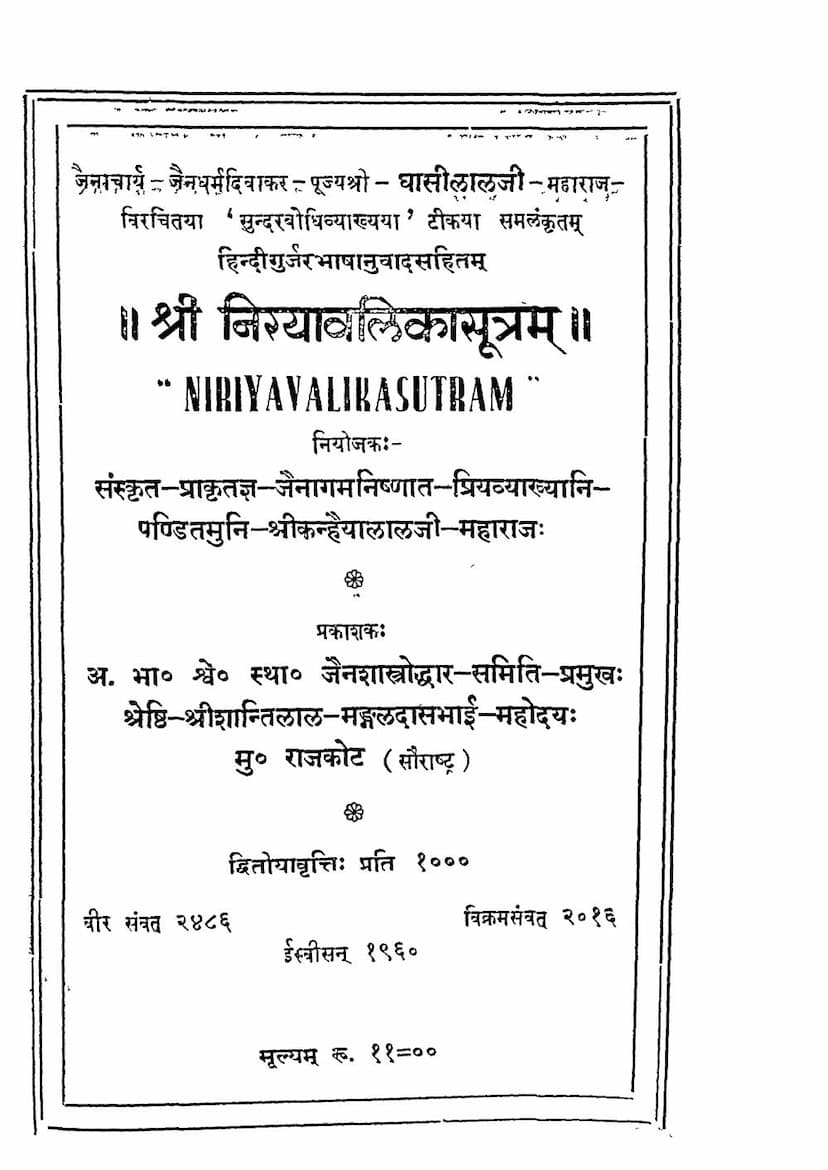Nirayavalikasutram
Added to library: September 2, 2025

Summary
Summary of Nirayavalikasutram by Ghasilal Maharaj
The provided text is a detailed summary and commentary on the Nirayavalikasutram, a Jain scripture, presented in Hindi and Gujarati with a commentary called Sundarbodhini by Ghasilal Maharaj. The catalog link indicates it is published by A B Shwetambar Sthanakwasi Jain Shastroddhar Samiti. The summary covers the contents of the Nirayavalikasutram, which is part of the Jain Agamas, specifically within the Dharmakathanuyog (narrative literature).
Book Overview:
- Title: Nirayavalikasutram (श्री निरयावलिकासूत्रम्)
- Author: Ghasilal Maharaj (जैनाचार्य - जैनधर्मदिवाकर - पूज्यश्री- घासीलालजी-महाराज)
- Commentary: Sundarbodhini Teeka (सुन्दरबोधिव्याख्याया) by Ghasilal Maharaj
- Publisher: A B Shwetambar Sthanakwasi Jain Shastroddhar Samiti
- Language: Sanskrit, Prakrit (original text), Hindi and Gujarati (translation and commentary)
- Edition: Second Edition
- Publication Year: Vir Samvat 2486 (2486), Vikram Samvat 2016 (2016), AD 1960
Core Content Summary of Nirayavalikasutram (as per the provided index and introductory sections):
The Nirayavalikasutram is one of the five Upangas (subsidiary scriptures) of the Jain Agamas, falling under the Dharmakathanuyog (narrative literature). It primarily narrates the lives and karmic consequences of ten K umaras (princes) and their mothers, all of whom were associated with King Shrenik of Rajgriha. The scripture is divided into ten studies, each focusing on one Kumar.
The summary highlights the following key aspects:
-
Introduction and Structure: The book begins with Mangalacharan (auspicious invocation) and then proceeds to describe the scriptures' origins and their classification within the Jain Agamas. It mentions the five Upangas: Nirayavalika, Kalpavataṃsika, Puṣpita, Puṣpacūlikā, and Vr̥ṣṇidaśā. Nirayavalika is described as an Upanga of Antakṛtadaśā (Antagaḍa Sūtra).
-
Genealogy and Characters: The text details the lineage of King Shrenik's family:
- King Shrenik: Had many queens, including Nanda, Chellana, Kali, Sukali, Mahakali, and others.
- Nanda's Son: Abhayakumar (who later became an ascetic).
- Chellana's Sons: Kūṇika, Vaihallya, and Vaihayas.
- Kali and other Ten Queens' Sons: Kāla, Sukāla, Mahākāla, Krishna, Sukrishna, Mahakrishna, Veerakrishna, Ramakrishna, Pitrusenakrishna, and Mahasenkrishna.
-
Kūṇika's Rebellion and Familial Conflict:
- Kūṇika, Chellana's son, allied with the ten princes from Kali and other queens, imprisoned King Shrenik, causing him great suffering.
- A significant episode involves Kūṇika's encounter with his mother Chellana. She expresses her displeasure at Kūṇika imprisoning his father, Shrenik.
- Chellana recounts Kūṇika's birth, including her pregnancy craving to eat Shrenik's liver (madhya-mansa) which was fulfilled by Shrenik. She also narrates how Kūṇika was abandoned as an infant due to this fear, but Shrenik rescued and cared for him, even sucking out pus from his wound. Chellana questions Kūṇika's behavior towards such a benevolent father.
- Kūṇika, upon hearing this, felt immense remorse. He intended to free Shrenik, but Shrenik, fearing Kūṇika's potential violence, consumed poison from his ring and died.
- Kūṇika, overcome with grief, moved his capital to Champanagari, dividing the kingdom into eleven parts, giving one to each of the ten princes and keeping the eleventh for himself.
-
Kala and Other Princes' Fate:
- The narrative details the tragic end of Kāla and the other nine princes (Sukāla, Mahākāla, Krishna, etc.) in battles against King Chetaka. They were killed by Chetaka's arrows, along with their armies, and due to their karma, went to hell (Niraya). This destruction is the basis for the scripture's name, "Nirayāvalikā" (the path to hell).
-
The Five Upangas: The introduction elaborates on the five Upangas:
- Nirayāvalikā: Describes the lives of Kāla and nine other princes in ten studies.
- Kalpavataṃsika: Describes ten princes from Padmakumar to Nandana, who were initiates of Lord Mahavir and attained heavenly states.
- Puṣpita: Describes ten Devatas (celestial beings) like Chandra and Surya, who visited Lord Mahavir and were advised of their future births and liberation.
- Puṣpacūlikā: Describes ten Devī (goddesses) like Shri and Hri, who visited Lord Mahavir and were told about their future births and liberation.
- Vr̥ṣṇidaśā: Describes twelve princes, including Nidhi, who were initiates of Lord Ariṣṭanemi and attained heavenly states before liberation.
-
Commentary (Sundarbodhini): The commentary by Ghasilal Maharaj is praised for its clarity and depth, making the original Sanskrit and Prakrit texts accessible through Hindi and Gujarati translations.
-
Emphasis on Samyaktva: The commentary extensively praises the virtue of Samyaktva (right faith/conviction) as the highest treasure, indispensable friend, and ultimate gain, drawing parallels from the lives of great souls.
-
Donors and Support: The latter part of the provided text lists numerous donors and life members who supported the publication, indicating a community effort to preserve and propagate Jain scriptures.
Overall Theme:
The Nirayavalikasutram, as explained through the commentary, serves to illustrate the principle of karma. It shows how actions, especially those driven by intense passions like greed, anger, and attachment, lead to severe consequences, including rebirths in lower realms (hells). The lives of these princes and their eventual liberation (for some) highlight the Jain path of detachment, asceticism, and the ultimate goal of moksha (liberation) through right faith, right knowledge, and right conduct. The commentary also emphasizes the importance of Samyaktva as the foundation for spiritual progress.